 |
EVSL
1.1.0
EigenValues Slicing Library
|
 |
EVSL
1.1.0
EigenValues Slicing Library
|
This file contains function prototypes and constant definitions internally used in EVSL. More...

Go to the source code of this file.
Functions | |
| int | chebxCoefd (int m, double gam, int damping, double *mu) |
| int | dampcf (int m, int damping, double *jac) |
| Computes damping coefficient for cheb. expansions. More... | |
| int | chebxPltd (int m, double *mu, int n, double *xi, double *yi) |
| function yi = chebxPltd computes yi = p_mu (xi), More... | |
| int | ChebAv (polparams *pol, double *v, double *y, double *w) |
| Computes y=P(A) v, where pn is a Cheb. polynomial expansion More... | |
| void | chext (polparams *pol, double aIn, double bIn) |
| Determines polynomial for end interval cases. More... | |
| int | apfun (const double c, const double h, const double *xi, double(*ffun)(double), const int npts, double *yi) |
| double | rec (const double a) |
| double | isqrt (const double a) |
| int | pnav (double *mu, const int m, const double cc, const double dd, double *v, double *y, double *w) |
| int | lsPol (double(*ffun)(double), BSolDataPol *pol) |
| void | savemat (csrMat *A, const char *fn) |
| void | savedensemat (double *A, int lda, int m, int n, const char *fn) |
| void | save_vec (int n, const double *x, const char fn[]) |
| int | SymmTridEig (double *eigVal, double *eigVec, int n, const double *diag, const double *sdiag) |
| compute all eigenvalues and eigenvectors of a symmetric tridiagonal matrix More... | |
| int | SymmTridEigS (double *eigVal, double *eigVec, int n, double vl, double vu, int *nevO, const double *diag, const double *sdiag) |
| compute eigenvalues and eigenvectors of a symmetric tridiagonal matrix in a slice More... | |
| void | SymEigenSolver (int n, double *A, int lda, double *Q, int ldq, double *lam) |
| interface to LAPACK SYMMETRIC EIGEN-SOLVER More... | |
| void | CGS_DGKS (int n, int k, int i_max, double *Q, double *v, double *nrmv, double *w) |
| Classical GS reortho with Daniel, Gragg, Kaufman, Stewart test. More... | |
| void | CGS_DGKS2 (int n, int k, int i_max, double *Z, double *Q, double *v, double *w) |
| Classical GS reortho. No test. just do i_max times used in generalized ev problems. More... | |
| void | orth (double *V, int n, int k, double *Vo, double *work) |
| Orthogonalize columns of n-by-k matrix V. More... | |
| void | contQuad (int method, int n, complex double *zk) |
| Compute the locations of the poles. More... | |
| void | ratf2p2 (int n, int *mulp, complex double *zk, complex double *alp, int m, double *z, double *x) |
| Compute the function value of the multiple pole rational filter at real locations. More... | |
| void | pfe2 (complex double s1, complex double s2, int k1, int k2, complex double *alp, complex double *bet) |
| Get the fraction expansion of 1/[(z-s1)^k1 (z-s2)^k2]. More... | |
| complex double | integg2 (complex double s1, complex double s2, complex double *alp, int k1, complex double *bet, int k2, double a, double b) |
| Integration of 1/[(z-s1)^k1 (z-s2)^k2] from a to b. More... | |
| void | weights (int n, complex double *zk, int *pow, double lambda, complex double *omega) |
| Compute the LS weight for each multiple pole. More... | |
| int | scaleweigthts (int n, double a, double b, complex double *zk, int *pow, complex double *omegaM) |
| Compute the weights and pole locations on [a, b]. More... | |
| void | RatFiltApply (int n, ratparams *rat, double *b, double *x, double *w3) |
| Apply rational filter R to a vetor b. More... | |
| void | simpson (double *xi, double *yi, int npts) |
| void | matvec_csr (double *x, double *y, void *data) |
| matvec for a CSR matrix, y = A*x. void *data points to csrMat, compatible form with EVSLMatvec (see struct.h) More... | |
| void | csr_resize (int nrow, int ncol, int nnz, csrMat *csr) |
| memory allocation for csr matrix More... | |
| void | sortrow (csrMat *A) |
| Sort each row of a csr by increasing column order By double transposition. More... | |
| int | matadd (double alp, double bet, csrMat *A, csrMat *B, csrMat *C, int *mapA, int *mapB) |
| matrix addition C = alp * A + bet * B More... | |
| int | speye (int n, csrMat *A) |
| return an identity matrix of dimension n More... | |
| void | triuCsr (csrMat *A, csrMat *U) |
| int | time_seeder () |
| Uses the timer to generate a seed to be used for srand. More... | |
| void | vecset (int n, double t, double *v) |
| void | vec_perm (int n, int *p, double *x, double *y) |
| void | vec_iperm (int n, int *p, double *x, double *y) |
This file contains function prototypes and constant definitions internally used in EVSL.
Definition in file internal_proto.h.
| int apfun | ( | const double | c, |
| const double | h, | ||
| const double *const | xi, | ||
| double(*)(double) | ffun, | ||
| const int | npts, | ||
| double * | yi | ||
| ) |
Evalutes ffun at the xi's. Assumes a transformation of original inetrval [a b] into [-1, 1] so: the xi's are between -1 and 1
| [in] | c | Value to increase xi's by |
| [in] | h | Value to scale xi's by |
| [in] | *xi | Points for which to evaluate ffun at |
| [in] | npts | Number of points in xi to evaluate |
| [in] | ffun | Function to evaluate |
| [out] | yi | ffun evaluated at xi's |
Definition at line 83 of file dos_utils.c.
References ffun().
Referenced by lsPol().


| void CGS_DGKS | ( | int | n, |
| int | k, | ||
| int | i_max, | ||
| double * | Q, | ||
| double * | v, | ||
| double * | nrmv, | ||
| double * | w | ||
| ) |
Classical GS reortho with Daniel, Gragg, Kaufman, Stewart test.
Definition at line 195 of file misc_la.c.
References DAXPY(), DDOT(), DGEMV(), DNRM2(), evsl_timer(), evslstat, and _evslstat::t_reorth.
Referenced by ChebLanNr(), ChebLanTr(), LanDosG(), LanTrbounds(), orth(), RatLanNr(), and RatLanTr().
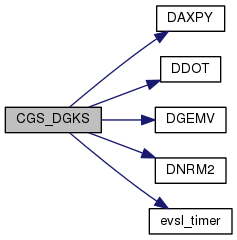
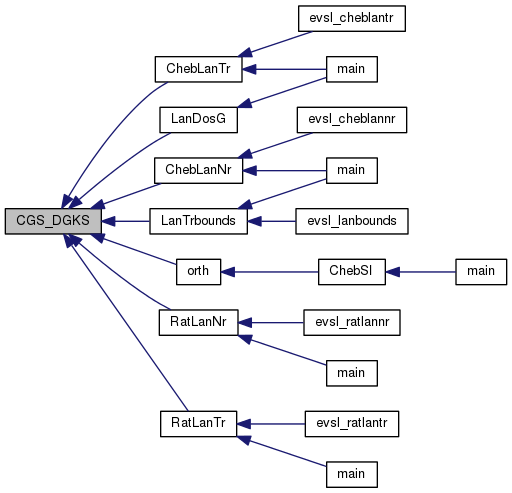
| void CGS_DGKS2 | ( | int | n, |
| int | k, | ||
| int | i_max, | ||
| double * | Z, | ||
| double * | Q, | ||
| double * | v, | ||
| double * | w | ||
| ) |
Classical GS reortho. No test. just do i_max times used in generalized ev problems.
Definition at line 235 of file misc_la.c.
References DAXPY(), DDOT(), DGEMV(), evsl_timer(), evslstat, and _evslstat::t_reorth.
Referenced by ChebLanNr(), ChebLanTr(), LanDosG(), LanTrbounds(), RatLanNr(), and RatLanTr().
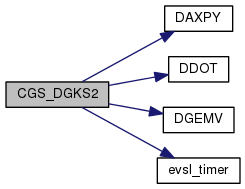
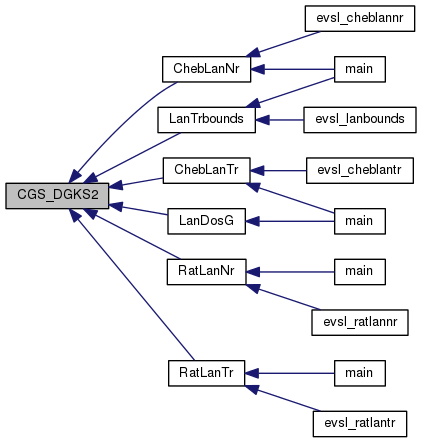
| int ChebAv | ( | polparams * | pol, |
| double * | v, | ||
| double * | y, | ||
| double * | w | ||
| ) |
Computes y=P(A) v, where pn is a Cheb. polynomial expansion
This explicitly calls matvec, so it can be useful for implementing user-specific matrix-vector multiplication.
| pol | Struct containing the paramenters and expansion coefficient of the polynomail. | |
| v | input vector | |
| [out] | y | p(A)v |
Workspace
| w | Work vector of length 3*n [allocate before call] |
| v | is untouched |
Definition at line 510 of file chebpoly.c.
References _polparams::cc, DAXPY(), _polparams::dd, _polparams::deg, DSCAL(), evsl_timer(), evsldata, evslstat, _evsldata::ifGenEv, _polparams::mu, _evsldata::n, _evslstat::n_polAv, _evslstat::t_polAv, and _evslstat::t_sth.
Referenced by ChebLanNr(), ChebLanTr(), and ChebSI().
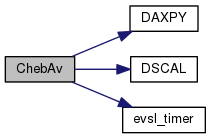
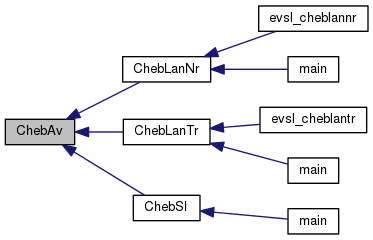
| int chebxCoefd | ( | int | m, |
| double | gam, | ||
| int | damping, | ||
| double * | mu | ||
| ) |
| int chebxPltd | ( | int | m, |
| double * | mu, | ||
| int | npts, | ||
| double * | xi, | ||
| double * | yi | ||
| ) |
function yi = chebxPltd computes yi = p_mu (xi),
where xi is a vectors of values. This can used for plotting the filter given by mu for example – Jackson (or other) dampings is not explicitly used here but is assumed to be multiplied by mu outside this routine.
| m | degree of the polynomial = length(mu)-1 |
| mu | Chev. expansion coefficients in KPM method |
| npts | = number of points in xi, yi |
| xi | = a vector of values where p(xi) is to be computed. |
| [out] | yi | = pn(xi(:) ) |
Definition at line 106 of file chebpoly.c.
References DAXPY(), Malloc, and vecset().
Referenced by find_pol(), and lsPol().


| void chext | ( | polparams * | pol, |
| double | aIn, | ||
| double | bIn | ||
| ) |
Determines polynomial for end interval cases.
In these cases, polynomial is just a scaled Chebyshev polynomial. However we need to express it in the same basis as in the other (middle interval) cases. This function determines this expansion
| aIn | The start index of the transformed interval |
| bIn | The end index of the transformed interval |
| pol | A struct containing the parameters of polynomial. |
Modifies mu Expansion coefficients of best polynomial found. deg: Degree of polynomial gam: Site of delta function that is expanded. Accurate 'balancing' is done: If p(t) is best approximation to delta function at gam then gam is selected so that p(a)=p(b) - within the tolerance tolBal (set in this function to 1.e-10) bar: If  bar, accept eigenvalue as belonging to interval; else reject.
bar, accept eigenvalue as belonging to interval; else reject.
Definition at line 171 of file chebpoly.c.
References _polparams::bar, Calloc, _polparams::deg, _polparams::gam, _polparams::max_deg, _polparams::mu, and _polparams::thresh_ext.
Referenced by find_pol().

| void contQuad | ( | int | method, |
| int | n, | ||
| complex double * | zk | ||
| ) |
Compute the locations of the poles.
----------------------— Cauchy integration-based filter -----------—
| method | 0 for Guass Legendre; 1 for midpoint | |
| n | Number of poles in the upper half plane | |
| [out] | zk | Vector of pole locations |
Definition at line 23 of file ratfilter.c.
References DSTEV(), M_PI, and Malloc.
Referenced by find_ratf().


| void csr_resize | ( | int | nrow, |
| int | ncol, | ||
| int | nnz, | ||
| csrMat * | csr | ||
| ) |
memory allocation for csr matrix
Definition at line 79 of file spmat.c.
References _csrMat::a, _csrMat::ia, _csrMat::ja, Malloc, _csrMat::ncols, _csrMat::nrows, and _csrMat::owndata.
Referenced by cooMat_to_csrMat(), csr_copy(), matadd(), speye(), and triuCsr().
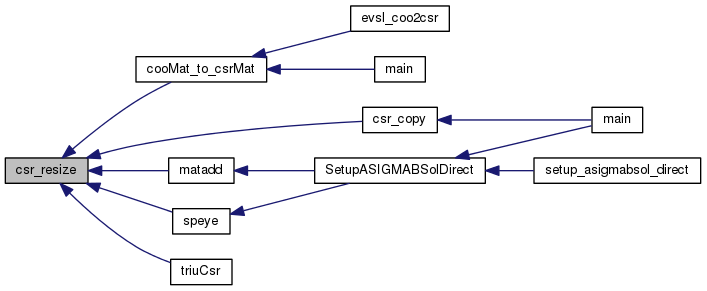
| int dampcf | ( | int | m, |
| int | damping, | ||
| double * | jac | ||
| ) |
Computes damping coefficient for cheb. expansions.
| damping | == 0 –> no damping == 1 –> Jackson == 2 –> Lanczos sigma damping | |
| m | degree of the polynomial | |
| [out] | jac | output array of dampened coefficients |
Definition at line 40 of file chebpoly.c.
References PI.
Referenced by find_pol(), and kpmdos().
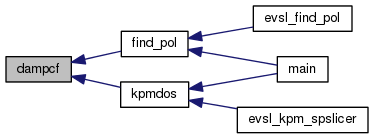
| complex double integg2 | ( | complex double | s1, |
| complex double | s2, | ||
| complex double * | alp, | ||
| int | k1, | ||
| complex double * | bet, | ||
| int | k2, | ||
| double | a, | ||
| double | b | ||
| ) |
Integration of 1/[(z-s1)^k1 (z-s2)^k2] from a to b.
Definition at line 129 of file ratfilter.c.
Referenced by weights().

| double isqrt | ( | const double | a | ) |
Definition at line 17 of file dos_utils.c.
Referenced by SetupPolSqrt().

| int lsPol | ( | double(*)(double) | ffun, |
| BSolDataPol * | pol | ||
| ) |
Finds the least-square polynomial approximation to function ffun in interval given by intv
| [in] | ffun | Function to generate an approximation for |
| [in,out] | pol | polparams struct \ Contains: cc = (a + b) / 2 \ dd = (b - a) / 2 \ mu = coefficients \ max_deg = number of coefficients |
Definition at line 168 of file dos_utils.c.
References apfun(), _BSolDataPol::cc, chebxPltd(), _BSolDataPol::dd, _BSolDataPol::deg, ffun(), _BSolDataPol::intv, linspace(), Malloc, _BSolDataPol::max_deg, _BSolDataPol::mu, and PI.
Referenced by SetupBPol().
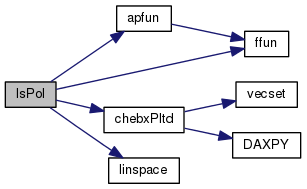

matrix addition C = alp * A + bet * B
| [in] | alp | |
| [in] | bet | |
| [in] | A | |
| [in] | B | |
| [out] | C |
| [out] | mapA | (of size nnzA or null), mapB (of size nnzB or null) if not null, on output mapA contains the location of each nonzero of A in the CSR matrix C, i.e. mapA[i] is the position of the corresponding entry in C.ja and C.a for entry in A.ja[i] and A.a[i] |
| [out] | mapB | the same as mapA |
Definition at line 307 of file spmat.c.
References _csrMat::a, csr_resize(), _csrMat::ia, _csrMat::ja, matadd_insert(), _csrMat::ncols, _csrMat::nrows, and Realloc.
Referenced by SetupASIGMABSolDirect().


| void matvec_csr | ( | double * | x, |
| double * | y, | ||
| void * | data | ||
| ) |
matvec for a CSR matrix, y = A*x. void *data points to csrMat, compatible form with EVSLMatvec (see struct.h)
Definition at line 247 of file spmat.c.
References _csrMat::a, dcsrmv(), _csrMat::ia, _csrMat::ja, _csrMat::ncols, and _csrMat::nrows.
Referenced by SetAMatrix(), and SetBMatrix().


| void orth | ( | double * | V, |
| int | n, | ||
| int | k, | ||
| double * | Vo, | ||
| double * | work | ||
| ) |
Orthogonalize columns of n-by-k matrix V.
| n | number of rows in V | |
| V | Matrix which columns are to be orthogonalized | |
| k | number of columns in V | |
| [out] | Vo | Output matrix |
| work | work |
Definition at line 269 of file misc_la.c.
References CGS_DGKS(), DCOPY(), DDOT(), DSCAL(), and NGS_MAX.
Referenced by ChebSI().
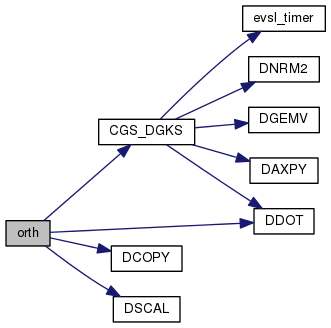

| void pfe2 | ( | complex double | s1, |
| complex double | s2, | ||
| int | k1, | ||
| int | k2, | ||
| complex double * | alp, | ||
| complex double * | bet | ||
| ) |
Get the fraction expansion of 1/[(z-s1)^k1 (z-s2)^k2].
Definition at line 95 of file ratfilter.c.
Referenced by weights().

| int pnav | ( | double * | mu, |
| const int | m, | ||
| const double | cc, | ||
| const double | dd, | ||
| double * | v, | ||
| double * | y, | ||
| double * | w | ||
| ) |
Computes y=P(A) v, where pn is a Cheb. polynomial expansion
This explicitly calls matvec, so it can be useful for implementing user-specific matrix-vector multiplication.
| [in] | mu | Coefficents of the cheb. polynomial (size m+1) |
| [in] | cc | cc member of pol struct |
| [in] | dd | dd member of pol struct |
| [in] | m | m member of pol struct |
| [in] | v | input vector |
| [out] | y | p(A)v |
Workspace
| [in,out] | w | Work vector of length 3*n [allocate before call |
Definition at line 109 of file dos_utils.c.
References evsldata, and _evsldata::n.
Referenced by BSolPol().

| void ratf2p2 | ( | int | n, |
| int * | mulp, | ||
| complex double * | zk, | ||
| complex double * | alp, | ||
| int | m, | ||
| double * | z, | ||
| double * | xx | ||
| ) |
Compute the function value of the multiple pole rational filter at real locations.
---------------—Multiple pole rational filter evaluation -----------—
| n | number of the pole | |
| mulp | multiplicity of the pole | |
| zk | array containing the poles. | |
| alp | fractional expansion coefficients | |
| m | number of locations to be evaluated | |
| z | real locations to be evaluated | |
| [out] | xx | : function values at real locations z |
Definition at line 69 of file ratfilter.c.
Referenced by scaleweigthts(), and weights().

| void RatFiltApply | ( | int | n, |
| ratparams * | rat, | ||
| double * | b, | ||
| double * | x, | ||
| double * | w6 | ||
| ) |
Apply rational filter R to a vetor b.
For generalized e.v problem x = L' * (A-SB) \ L*b [w:=work] x = L * b w = (A-sB) \ x x = L' * w
| [in] | rat | ratparams struct |
| [in] | n | Length of array |
| [in] | b | x = L * b |
| w6 | Work array of size 4*n for standard ev problem, size 6*n for generalized ev problem | |
| [out] | x | Becomes R(A)b |
Definition at line 448 of file ratfilter.c.
References _ratparams::ASIGBsol, DAXPY(), DSCAL(), evsl_timer(), evsldata, evslstat, _evsldata::ifGenEv, _ratparams::mulp, _evslstat::n_ratAv, _ratparams::num, _ratparams::omega, and _evslstat::t_ratAv.
Referenced by RatLanNr(), and RatLanTr().
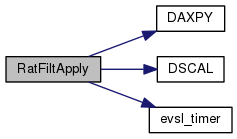
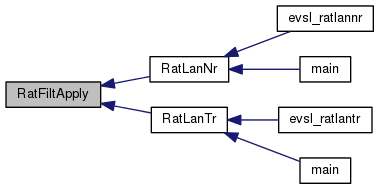
| double rec | ( | const double | a | ) |
Definition at line 15 of file dos_utils.c.
Referenced by SetupPolRec().

| void save_vec | ( | int | n, |
| const double * | x, | ||
| const char | fn[] | ||
| ) |
Definition at line 38 of file dumps.c.
Referenced by spslicer(), and SymmTridEig().
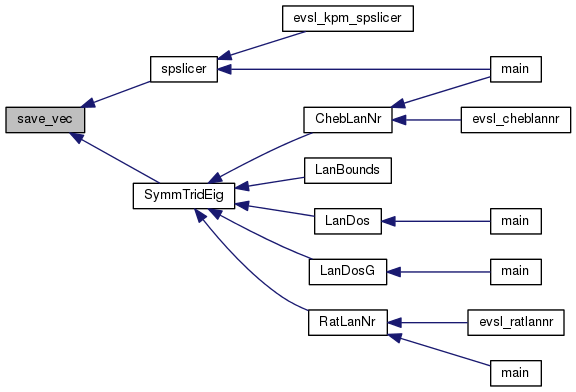
| void savedensemat | ( | double * | A, |
| int | lda, | ||
| int | m, | ||
| int | n, | ||
| const char * | fn | ||
| ) |
| void savemat | ( | csrMat * | A, |
| const char * | fn | ||
| ) |
Definition at line 33 of file dumps.c.
References _csrMat::a, _csrMat::ia, _csrMat::ja, _csrMat::ncols, _csrMat::nrows, and save_mtx_basic().

| int scaleweigthts | ( | int | n, |
| double | a, | ||
| double | b, | ||
| complex double * | zk, | ||
| int * | mulp, | ||
| complex double * | omegaM | ||
| ) |
Compute the weights and pole locations on [a, b].
---------------—Transform poles and weights computed on [-1, 1] to [a, b] -------—
| n | number of poles used in the upper half plane | |
| a,b | [a, b] is the interval of desired eigenvalues | |
| zk | location of the poles | |
| mulp | multiplicity of the poles | |
| [out] | omegaM | multiple LS weights |
Definition at line 313 of file ratfilter.c.
References ratf2p2().
Referenced by find_ratf().


| void simpson | ( | double * | xi, |
| double * | yi, | ||
| int | npts | ||
| ) |
This function computes the integrals from xi[0] to xi[j] for j=0:npts-1
| [in] | xi | npts equally space points |
| [in] | yi | values of a function f at the xi |
| [in] | npts | number of sample points |
In-place version.
Definition at line 27 of file simpson.c.
Referenced by LanDos(), LanDosG(), and spslicer2().
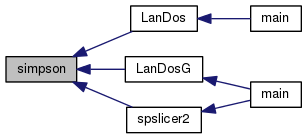
| void sortrow | ( | csrMat * | A | ) |
Sort each row of a csr by increasing column order By double transposition.
Definition at line 56 of file spmat.c.
References _csrMat::a, csrcsc(), _csrMat::ia, _csrMat::ja, Malloc, _csrMat::ncols, and _csrMat::nrows.
Referenced by cooMat_to_csrMat().


| int speye | ( | int | n, |
| csrMat * | A | ||
| ) |
return an identity matrix of dimension n
Definition at line 357 of file spmat.c.
References _csrMat::a, csr_resize(), _csrMat::ia, and _csrMat::ja.
Referenced by SetupASIGMABSolDirect().


| void SymEigenSolver | ( | int | n, |
| double * | A, | ||
| int | lda, | ||
| double * | Q, | ||
| int | ldq, | ||
| double * | lam | ||
| ) |
interface to LAPACK SYMMETRIC EIGEN-SOLVER
Definition at line 156 of file misc_la.c.
References DSYEV(), evsl_timer(), evslstat, Malloc, and _evslstat::t_eig.
Referenced by ChebLanTr(), ChebSI(), LanTrbounds(), and RatLanTr().

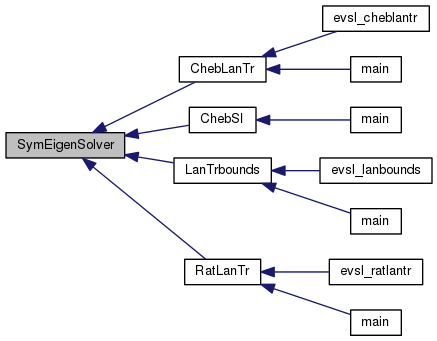
| int SymmTridEig | ( | double * | eigVal, |
| double * | eigVec, | ||
| int | n, | ||
| const double * | diag, | ||
| const double * | sdiag | ||
| ) |
compute all eigenvalues and eigenvectors of a symmetric tridiagonal matrix
| n | The dimension of the symmetric tridiagonal matrix | |
| diag[],sdiag[] | Define the symmetric tridiagonal matrix: the diagonal elements are diag[0,...,n-1] in order and the subdiagonal elements are sdiag[0,...,n-2] in order | |
| [out] | eigVal | The output vector of length n containing all eigenvalues in ascending order |
| [out] | eigVec | The output n-by-n matrix with columns as eigenvectors, in the order as elements in eigVal. If NULL, then no eigenvector will be computed |
Definition at line 36 of file misc_la.c.
References DSTEV(), evsl_timer(), evslstat, Malloc, save_vec(), and _evslstat::t_eig.
Referenced by ChebLanNr(), LanBounds(), LanDos(), LanDosG(), and RatLanNr().
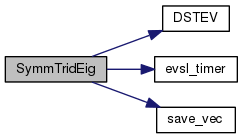
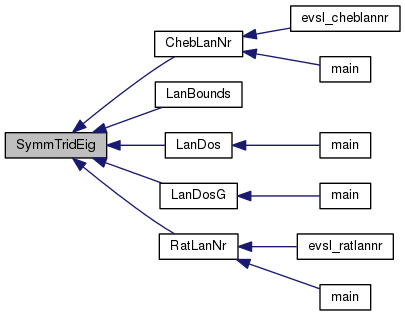
| int SymmTridEigS | ( | double * | eigVal, |
| double * | eigVec, | ||
| int | n, | ||
| double | vl, | ||
| double | vu, | ||
| int * | nevO, | ||
| const double * | diag, | ||
| const double * | sdiag | ||
| ) |
compute eigenvalues and eigenvectors of a symmetric tridiagonal matrix in a slice
| n | The dimension of the symmetric tridiagonal matrix | |
| diag[],sdiag[] | define the symmetric tridiagonal matrix. | |
| [out] | eigVal | Total number of eigenvalues found. |
| [out] | eigVec | The first M elements contain teh selected eigenvalues in ascending oredr |
| [in] | vl | If range='V', The lower bound of the interval to be searched for eigen values. |
| [in] | vu | If range='V', the upper bound of the interval to be searched for eigenvalues. |
| [in] | nevO | If range='I', the index of the smallest eigen value to be returned. |
This routine computes selected eigenvalues/vectors as specified by a
Definition at line 93 of file misc_la.c.
References Calloc, DSTEMR(), evsl_timer(), evslstat, Malloc, and _evslstat::t_eig.
Referenced by ChebLanNr(), and RatLanNr().

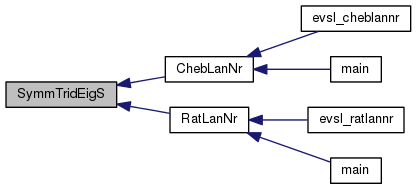
| int time_seeder | ( | ) |
Uses the timer to generate a seed to be used for srand.
Uses the timer to generate a seed to be used for srand.
Definition at line 30 of file mactime.c.
References evsl_timer().
Referenced by kpmdos().


Definition at line 424 of file spmat.c.
References _csrMat::a, CHKERR, csr_resize(), EVSL_Int, EVSL_Unsigned, _csrMat::ia, _csrMat::ja, _csrMat::ncols, and _csrMat::nrows.

| void vecset | ( | int | n, |
| double | t, | ||
| double * | v | ||
| ) |
Definition at line 48 of file vect.c.
Referenced by chebxPltd().

| void weights | ( | int | n, |
| complex double * | zk, | ||
| int * | mulp, | ||
| double | lambda, | ||
| complex double * | omega | ||
| ) |
Compute the LS weight for each multiple pole.
---------------—multiple pole LS rational filter weights-----------—
| n | number of poles in the upper half plane | |
| zk | pole locations | |
| mulp | multiplicity of each pole | |
| lambda | LS integration weight for [-1, 1] | |
| [out] | omega | LS weight for each pole |
Definition at line 169 of file ratfilter.c.
References integg2(), Malloc, pfe2(), ratf2p2(), and ZGESV().
Referenced by find_ratf().
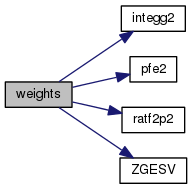

 1.8.6
1.8.6